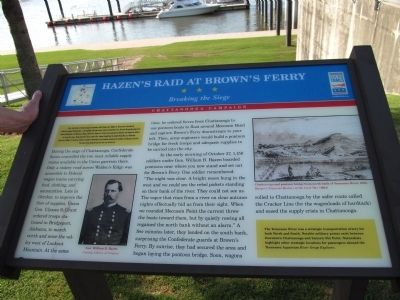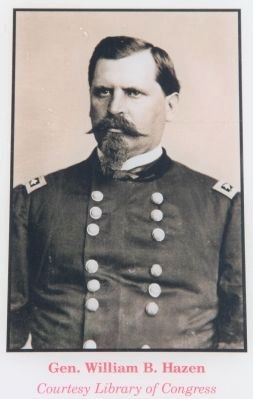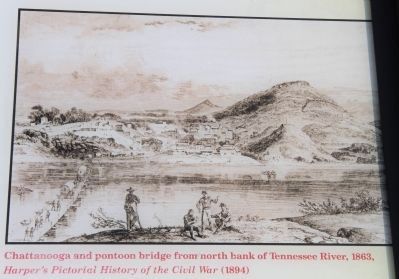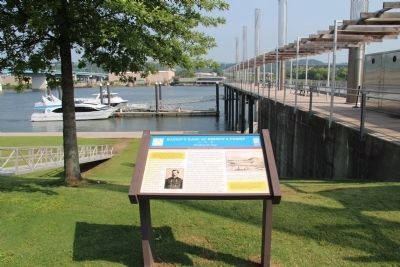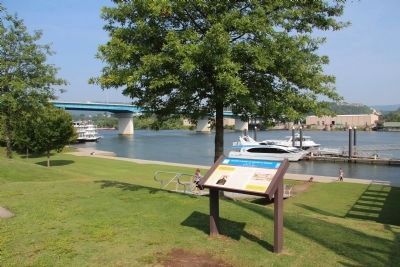Riverfront in Chattanooga in Hamilton County, Tennessee — The American South (East South Central)
Hazen's Raid at Brown's Ferry
Breaking the Siege
First Insert:
After the Battle of Chickamauga in September 1863, Union Gen. William S. Rosecrans retreated to Federal-occupied Chattanooga, a strategically vital rail center, where Confederate Gen. Braxton Bragg laid siege from Lookout Mountain and Missionary Ridge. Union Gen. Ulysses S. Grant took command in October and began his efforts to break the siege. Bragg detached forces under Gen. James Longstreet to attack Knoxville as a diversion. After Gen. William T. Sherman reinforced Grant in November, the Federals attacked the heights and Bragg retreated. The Union army held the city for the rest of the war.
Main marker text:
During the siege of Chattanooga, Confederate forces controlled the two most reliable supply routes available to the Union garrison there. Only a rickety road across Walden’s Ridge was accessible to Federal wagon trains carrying food, clothing, and ammunition. Late in October, to improve the flow of supplies, Union Gen. Ulysses S. Grant ordered troops stationed in Bridgeport, Alabama, to march north and seize the valley west of Lookout Mountain. At the same time, he ordered forces from Chattanooga to use pontoon boats to float around Moccasin Bend and capture Brown’s Ferry downstream to your left. Then, army engineers would build a pontoon bridge for fresh troops and adequate supplies to be carried into the city.
In the early morning of October 27, 1,150 soldiers under General William B. Hazen boarded pontoons near where you now stand and set out for Brown’s Ferry. One soldier remembered: “The night was clear. A bright moon hung in the west and we could see the rebel pickets standing on their bank of the river. They could not see us. The vapor that rises from a river on clear autumn nights effectually hid us from their sight. When we rounded Moccasin Point the current threw the boats toward them, but by quietly rowing all regained the north bank without an alarm.” A few minutes later, they landed on the south bank, surprising the Confederate guards at Brown’s Ferry. By sunrise, they had secured the area and began laying the pontoon bridge. Soon, wagons rolled to Chattanooga by the safer route called the Cracker Line (for the wagonloads of hardtack) and eased the supply crises in Chattanooga.
Second Insert:
The Tennessee River was a strategic transportation artery for both North and South. Notable military points exist between Downtown Chattanooga and historic Pot Point. Naturalists highlight other strategic locations for passengers aboard the Tennessee Aquarium River Gorge Explorer.
Erected by Tennessee Civil War Trails.
Topics. This historical marker is listed
in these topic lists: Bridges & Viaducts • War, US Civil • Waterways & Vessels. A significant historical month for this entry is September 1863.
Location. 35° 3.369′ N, 85° 18.784′ W. Marker is in Chattanooga, Tennessee, in Hamilton County. It is in Riverfront. Marker is on Riverfront Parkway, 0.1 miles north of Power Alley, on the left when traveling east. Touch for map. Marker is in this post office area: Chattanooga TN 37402, United States of America. Touch for directions.
Other nearby markers. At least 8 other markers are within walking distance of this marker. Ross's Landing (about 400 feet away, measured in a direct line); "Cherokee" (about 500 feet away); Chattanooga's First Citizens (about 500 feet away); 1790 John Ross 1866 (about 500 feet away); a different marker also named Ross's Landing (approx. 0.2 miles away); Trail of Tears (approx. 0.2 miles away); Stickball / Seven Sisters (approx. 0.2 miles away); Cameron Hill (approx. 0.2 miles away). Touch for a list and map of all markers in Chattanooga.
More about this marker. Very nice historical marker right near the Chattanooga Pier, right in downtown Chattanooga and in the Ross's Landing Park.
Additional keywords. Chattanooga,
Ross's Landing, Hazen, Brown's Ferry, pontoon boats, Civil War, Chattanooga Campaign
Credits. This page was last revised on February 7, 2023. It was originally submitted on June 25, 2013, by Austin Menzmer of Chattanooga, Tennessee. This page has been viewed 1,006 times since then and 44 times this year. Photos: 1. submitted on June 25, 2013, by Austin Menzmer of Chattanooga, Tennessee. 2, 3, 4, 5, 6. submitted on June 10, 2015, by Dale K. Benington of Toledo, Ohio. • Bill Pfingsten was the editor who published this page.
